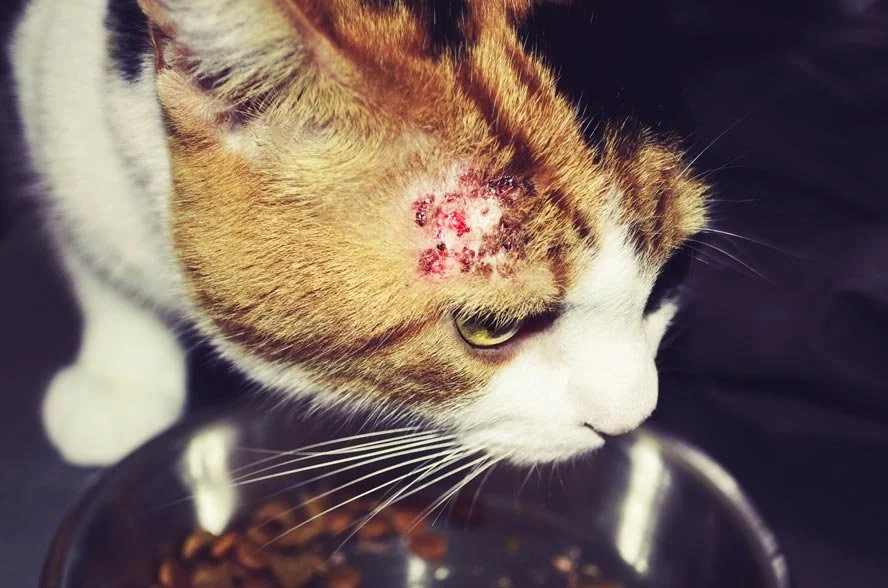cover: Milada Vigerova | Shutterstock
My cat has a bald spot on its neck. Where the bald spot on the neck of the cat comes from is quickly explained. Even if you haven't caught it yet: Your cat has probably scratched off its own fur. It can easily reach it with the sharp claws of its hind paw.
And now the problem begins, because you need to find out why your cat is scratching. The causes of itching are many and varied and each requires a different treatment. We'll explain which conditions are possible and how you can help your cat.
What if cats have bald spots?
With their sharp claws, cats can quickly injure themselves if they scratch excessively. This can lead to bald areas on the neck, but also on other easily accessible parts of the body. Often the affected skin is reddened or even bleeds. But there are also diseases that cause hair loss. If these areas are also itchy, your cat will scratch and hurt itself. It is therefore not always easy to distinguish whether the hair loss was already present before the scratching.
Why cats scratch excessively can have many reasons. Most itch-causing diseases are easy to treat once they have been diagnosed. And there the problem begins. It can take some time before you know what is underlying it. Often it takes several examinations and tests to find out.
Possible causes:
parasite infestation
flea allergy dermatitis
food intolerance
cutaneous fungus
psychologically induced hair loss
photowind | Shutterstock
Parasite infestation
Many parasites that live on or in the skin cause itching. Fleas are the most common, but lice and various types of mites such as fur mites or mange mites also occur. Depending on the type of parasite, there is a different pattern in the hairless areas, because it often does not stop at the bald spot on the neck.
Larger parasites like fleas and lice can be seen with the bare eye. To detect the smaller crawlers, a so-called skin scraping is examined in the veterinary practice. Then the targeted treatment with an effective antiparasitic can begin. In most cases, the companions must also be treated, even if they show no symptoms. Otherwise there would be a constant re-infection.
Flea allergy dermatitis
The saliva of fleas helps them to suck blood, because the blood does not clot as quickly. The problem is that some cats are allergic to it. This can cause a reaction all over the body, including severe itching and skin inflammation.
Fleas hide in the environment and only go to their host to suck blood. Therefore, the easiest way to detect them is through their droppings, which they leave as black crumbs in the fur. Rub them on a damp cloth. If they turn red, this is evidence of a digested blood meal. Treat your cat with spot-ons or tablets. To get rid of the bloodsuckers permanently, it is also essential to treat and clean the environment. They produce their offspring in scratching posts, sofas, floorboard cracks and so on. You can get rid of them with so-called foggers and a hoover.
Jaromir Chalabala | Shutterstock
Food intolerance
It has been occurring more and more frequently for years. Food intolerance is an overreaction of the body to various food ingredients. Even food that your cat has been eating for a long time can suddenly no longer be tolerated. The exact reasons for this are unclear.
Food intolerances are manifested by itching, ear infections, diarrhoea and vomiting. If you suspect this, the only way to help is an elimination diet. For weeks, your cat will only be allowed to eat food that consists of a few ingredients that are always the same. Additional treats are unfortunately taboo. When the symptoms have disappeared, you can gradually add more food to the diet.
Cutaneous fungus
Cutaneous fungal spores are common all over the world, but so-called dermatophytosis usually only occurs in weakened animals, such as young, malnourished, parasite-infested and unkempt cats. The disease manifests itself by round to oval hairless areas that are scaly and not always itchy.
The treatment of a fungal skin disease is lengthy and should be carried out externally by washing with special shampoos or sprays in addition to the administration of an antimycotic. To prevent re-infection, it is necessary to disinfect the environment and to clean all contact objects of the affected cat. This is because the spores remain in carpets, toys, litter trays, etc.
Psychogenic alopecia
Sometimes cats overdo their personal hygiene. Our velvet paws are very sensitive and can react to various stress factors with this behavioural disorder. Often the belly and the inner thighs are affected. Self-inflicted minor injuries can then lead to itching and inflammation and the cat licks and scratches even more intensively - it is a vicious circle.
Psychologically induced hair loss is a diagnosis of exclusion if no physical cause can be found. In this case, further research is needed to find out why your cat is so stressed. Often simple measures can help to relax it. For example, a new window seat or an additional litter tray can do wonders. The use of feel-good pheromones, which are vaporised via the socket, can also help many cats.
LedyX | Shutterstock
Can an indoor cat get mites?
Unfortunately, yes. Even if your cat never leaves the flat, it can still get mites. How is this possible? Mites are usually transmitted from cat to cat through direct physical contact, but they also survive for some time on surfaces and objects. Mite infestation is relatively common in wild and outdoor cats, so the crawlers then enter our streets, gardens and parks. Therefore, we can bring the mites into our homes unnoticed via shoes, blankets or other objects. The same applies to fleas and certain viruses and bacteria. So your indoor cat is not protected just because it doesn't go outside.
Why does my cat scratch its neck?
It's simple: because it's itchy and she can reach the spot perfectly. Cats are very flexible and can reach almost any part of the body when grooming and scratching. The claws are extended and serve as a scratching aid. Unfortunately, your cat can also hurt itself in the process if the itch becomes too intense or the skin is already damaged.
The only place they don't reach is on the upper back between the shoulder blades. This is used when administering medication like so-called spot-ons against ectoparasites, which the cat should not lick.
rachanon cumnonchai | Shutterstock
When to go to the vet?
If your cat scratches itself bald, you should act. There are many possible causes that need to be investigated and treated. The confidu diagnosis finder developed by vets can help you. Answer questions about the symptom and get information about if and when you should go to a veterinary practice. You will also receive help on how to support your cat at home.
If your cat is not eating, is weak or has a fever, you should go to the vet immediately. Also, if the area is large and inflamed, professional wound care is necessary.
Bald spots - not only common on the neck!
Your cat can be bald not only on the neck, but also on other parts of the body. Often the hairless areas are not only licked bald, but the hair may have fallen out. Depending on the cause, there are even very specific patterns that are typical.
Bald spot on the belly
If your cat has a bald belly, this is an indication of a so-called psychogenic alopecia. Simply put, your cat will lick his belly until all the hair is gone. And it also keeps licking off the hair that grows back.
Cats are very sensitive and can react to stress with an exaggerated grooming instinct. A new family member can be just as much a trigger as being alone for a long time or the building site in front of the house. If a physical cause can be ruled out, you should get to the bottom of the matter. Often, simple measures can help your cat to relax again.
Miroslav Pesek | Shutterstock
Bald spots above the eyes
This is another area that your cat is excellent at scratching. A bald spot will therefore quickly form above the eyes as it becomes increasingly itchy. Often the skin on the area is reddened, sometimes even small red pustules appear. Usually both sides of the eye are affected.
The most common reason for a bald spot above the eyes is food intolerance, but a flea allergy or an environmental allergy can also be behind it. For example, cats can be allergic to dust mites or certain pollen, just like humans. To find out the cause of the bald spots, veterinary expertise is needed. Only then the right treatment can be applied.
Bald spot on the head
If your cat's head is bald, parasites are probably the culprit. Head mange and fur mites in particular cause terrible itching and crusting. In most cases, it is not just the head that is affected, but the spots spread to other parts of the body. Cutaneous fungi also live parasitically and cause hair loss on the head. Most of the time the spots are circular and the skin is scaly.
If your cat shows such signs, it will most likely need medication. Of course, a veterinary examination should be done first to clarify the situation.
Conclusion
A bald spot on the neck is a common symptom in cats. The causes are varied and often require treatment with medication. It can be caused by parasites, food intolerance or a cutaneous fungus. Sometimes it is simply because your cat is feeling stressed.
To help your cat, you can try the confidu diagnosis finder. It will help you assess the severity of the symptom and give you specific recommendations for action. This might save you an unnecessary trip to the vet's office. Or it will make it clear to you that you should go promptly instead of waiting for improvement.
The confidu magazine is written by our veterinarians according to current scientific standards. The articles do not replace a veterinary diagnosis, but are intended to provide you with initial information on many topics related to your animal. If you have specific questions about your pet, our vets will be happy to advise you via the confidu app.










